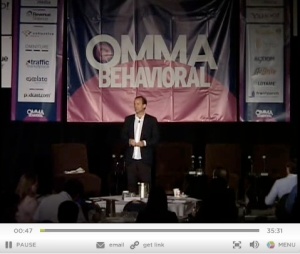A great deal of fear surrounds certain online advertising techniques variously described as behavioural (or behavioral) targeting. Put simply, a website, ISP, advertising network or other online entity that can access your data puts together a profile of your browsing habits and uses this information to serve you better targeted advertising. The argument is that you will prefer these advertisements because they are more relevant and you will therefore recall the brand and have a more positive response to the advertiser because the ads are engaging and not intrusive (see Yahoo’s take and case studies on BT).
The dark side of the behavioural space is that your personal browsing patterns are analysed, recorded and used to generate an advertising campaign by people you’ve never heard of. They say all information is decoupled from personal data, often segmented and grouped, so that no one can match the behavioural information to you – but who really believes that?
Well, whether it’s true or not, it’s perception that carries weight in the advertising world, with all things. A recent study by TRUSTe and TNS uncovered significant distrust within the internet community regarding behavioural advertising and the use of personal data for targeting:
71 percent of online consumers are aware that their browsing information may be collected by a third party for advertising purposes, but only 40 percent are familiar with the term “behavioral targeting.” 57 percent of respondents say they are not comfortable with advertisers using that browsing history to serve relevant ads, even when that information cannot be tied to their names or any other personal information.
An overwhelming majority (91 percent) of respondents expressed willingness to take necessary steps to assure increased privacy online when presented with the tools to control their internet tracking and advertising experience, suggesting a need for added education, transparency and choices for behavioral targeting. Nearly two-thirds (64 percent) would choose to see online ads only from online stores and brands that they know and trust and 44 percent of respondents would click buttons or icons to make that happen.
To the contrary, a similar proportion of consumers (42 percent) say they would sign up for an online registry to ensure that advertisers are not able to track browsing behaviors, even if it meant that they would receive more ads that are less relevant to their interests. This division poses a serious dilemma for BT practitioners and industry privacy advocates, because consumers say they want more relevant advertising, but don’t want to be tracked in order to get it. [bolding added by blog]
Reuters reported that on Friday last week senior members of the United States’ House Energy and Commerce Committee wrote to more than 30 broadband internet providers and other online companies, including Comcast, AT&T, Verizon, Google and Microsoft, asking whether they have “tailored, or facilitated the tailoring of, Internet advertising based on consumers [sic] Internet search, surfing, or other use.”
This government-sanctioned fear of Internet privacy violation could make it very difficult for purveyors of behavioural advertising platforms to gain the trust of users. Will this fear break through to advertisers and stop them using behavioural, or other, systems?
The attempt to bring ISPs into the behavioural fold has been met with major concern in the UK, Europe and USA, as outlined recently in Sean Carmody’s post, Poor Phorm, where he discusses how Phorm, NebuAd and FrontPorch are being used to profile surfers directly at the ISP, to assist the pipe providers gain a share of the advertising dollar.
As privacy groups and commentators identify these concerns, will users shy away from ISPs that trade on data collection and will advertisers, like politicians, run from anything with a bad odour? Is behavioural targeting so demonstrably superior in performance to sophisticated contextual targeting that major advertisers will continue taking the risk of negative publicity if the pressure from consumer watchdog and government bodies continues to build?
Filed under: Online Advertising | Tagged: Behavioral Targeting, Behavioural Targeting, Contextual Targeting, FrontPorch, House Energy Commerce Committee, ISP, NebuAd, Online Advertising, Phorm, TNS, TRUSTe | 3 Comments »








